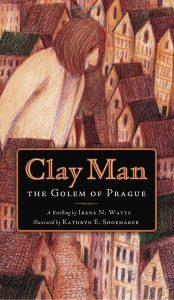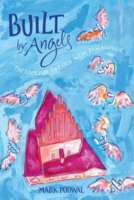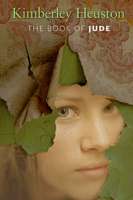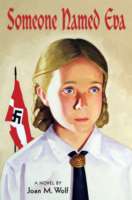Czech Republic
Materials from Czech Republic
Clay Man: The Golem Of Prague
 It is 1595, and the rabbi’s son Jacob is frustrated with having to live in the walled ghetto known as Jewish Town. Why can’t he venture outside of the gates and explore the beautiful city? His father warns him that Passover is a dangerous time to be a Jew and that the people from outside accuse the Jews of dreadful deeds. But one night, Jacob follows his father and two companions as they unlock the ghetto gates and proceed to the river, where they mold a human shape from the mud of the riverbank. When the rabbi speaks strange words, the shape is infused with life and the Golem of Prague is born.In this breathtaking retelling of a timeless tale, Irene N. Watts’s beautiful words are complemented by the haunting black-and-white images of artist Kathryn E. Shoemaker.
It is 1595, and the rabbi’s son Jacob is frustrated with having to live in the walled ghetto known as Jewish Town. Why can’t he venture outside of the gates and explore the beautiful city? His father warns him that Passover is a dangerous time to be a Jew and that the people from outside accuse the Jews of dreadful deeds. But one night, Jacob follows his father and two companions as they unlock the ghetto gates and proceed to the river, where they mold a human shape from the mud of the riverbank. When the rabbi speaks strange words, the shape is infused with life and the Golem of Prague is born.In this breathtaking retelling of a timeless tale, Irene N. Watts’s beautiful words are complemented by the haunting black-and-white images of artist Kathryn E. Shoemaker.
Suzy Goose and the Christmas Star
Tenacious Suzy Goose aims to top her Christmas tree with a star from the sky — with unexpectedly wondrous results — in this vibrant, whimsical tale. It’s Christmas Eve, and Suzy Goose and her friends are admiring their beautifully decorated tree. It’s perfect except for one thing: a star for the top. But Suzy sees just the right one, high in the sky, and no one can stop her from trying every possible way to get it.
Built by Angels

As legend tells it, the Old-New Synagogue in Prague was built by angels, and later was home to a golem who remains locked away in the building to this day. In lyrical prose, Mark Podwal shares the story of the world’s oldest active synagogue, which was completed in 1270. Throughout the years, this sacred place of prayer and celebration has endured plagues, wars, and the Nazi regime. Its story is part legend, part history, and one that stands as a testament to the perseverance of the Jewish people.
A New Frontier: The Peace Corps in Eastern Europe
A collection of black-and-white photographs offers a dramatic portrait of the Peace Corps teachers, business specialists, and other volunteers in the ex-Communist countries of Eastern Europe.
The Book of Jude

In 1989, when fifteen-year-old Jude’s mother wins a Fulbright fellowship to study art in Czechoslovakia, the family postpones a planned move to Utah to join her, but the political situation and the move itself are too much for Jude, who is overwhelmed by a previously undiagnosed psychological disorder.
You Can Go Home Again
The woman describes her childhood and her Aunt Anna and Uncle Billy, who lived in a wonderful mansion filled with beautiful carpets, vases, and paintings. Most special of all were four ebony elephants that she loved to played with. When World War II began, she was sent to live in Canada and, while she was gone, her aunt, uncle, and father died. After hearing the story, Annie wants to visit the old country, and her mother agrees that it is time. Annie is determined to find the elephants, but it is not until they visit a restaurant on their last night that she discovers the figurines in a glass case and hears the story of how Uncle Billy left them there for his niece to find.
Someone Named Eva

On the night Nazi soldiers come to her home in Czechoslovakia, Milada’s grandmother says, “Remember, Milada. Remember who you are. Always.” Milada promises, but she doesn’t understand her grandmother’s words. After all, she is Milada, who lives with her mama and papa, her brother and sister, and her beloved Babichka. Milada, eleven years old, the fastest runner in school. How could she ever forget?Then the Nazis take Milada away from her family and send her to a Lebensborn center in Poland. There, she is told she fits the Aryan ideal: her blond hair and blue eyes are the right color; her head and nose, the right size. She is given a new name, Eva, and trained to become the perfect German citizen, to be the hope of Germany’s future—and to forget she was ever a Czech girl named Milada.Inspired by real events, this fascinating novel sheds light on a little-known aspect of the Nazi agenda and movingly portrays a young girl’s struggle to hold on to her identity and her hope in the face of a regime intent on destroying both.
The Golem: A Version

A saintly rabbi miraculously brings to life a clay giant who helps him watch over the Jews of sixteenth-century Prague.
The Wall: Growing Up Behind the Iron Curtain
Peter Sis draws us into the world that shaped him–Czechoslovakia during the Cold War. World War II had ended, and the Germans had left, but Czechoslovakia was still an occupied country, this time by the Russians. As tensions between Eastern Europe and the free world intensified, borders to the West were fortified with fences and walls–the Iron Curtain had descended. Behind it were many people who wanted to be free. And as Peter grows up, he becomes one of them.
Through annotated illustrations, journals, maps, and dreamscapes, Peter Sís shows what life was like for a child who loved to draw, proudly wore the red scarf of a Young Pioneer, stood guard at the giant statue of Stalin, and believed whatever he was told to believe. But adolescence brought questions. Cracks began to appear in the Iron Curtain, and news from the West slowly filtered into the country. Sís learned about beat poetry, rock ’n’ roll, blue jeans, and Coca-Cola. He let his hair grow long, secretly read banned books, and joined a rock band. Then came the Prague Spring of 1968, and for a teenager who wanted to see the world and meet the Beatles, this was a magical time. It was short-lived, however, brought to a sudden and brutal end by the Soviet-led invasion.
